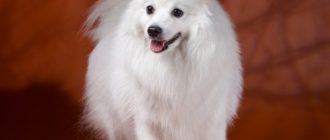Assessment of breed characteristics
Contents
| Adaptability Definition of how easy a dog is. can adapt to changes in life. |  |
| Shedding Level Level and frequency of hair loss in animal. |  |
| Level of tenderness Level and amount of tenderness and affection that the dog gives back in return for attention to itself. |  |
| Need for Exercise Daily Activity Level dogs. |  |
| Social need Required number of dog contacts with other animals as well as people. |  |
| Housing ratio Factor that determines the level of noise and other inconvenience that the dog can deliver to the owners in the ratio the size of the apartment to the size of the dog. |  |
| Grooming Number of bathing, combing, as well as necessary number of professional grooming sessions required the dog. |  |
| Friendliness in an unfamiliar environment society with strangers or in an unfamiliar environment. |  |
| The tendency to bark The tendency to bark and its frequency and volume. |  |
| Health Issues Potential Health Status dogs. |  |
| Territorial tendency of the dog to protect his house, yard or even a car owner. |  |
| Cat friendliness A trend towards cat tolerance and reduced manifestation of hunting instincts. |  |
| Intelligence Dog’s ability to think and solve emerging difficulties (not to be confused with learning!). |  |
| Education and training Level of difficulty in training a dog perform certain actions. |  |
| Friendliness for children Factor determining how much the dog friendly to children, whether she likes to play with them and endure some children’s pranks. |  |
| Game activity The concept is determined by its very name, and, usually found in almost all dogs. |  |
| Observability Dog’s ability to detect presence a stranger in his territory. |  |
| Friendliness for other dogs Dog’s tendency to find common language with other relatives. |  |
Brief description of the breed
Fox terriers were originally bred for fox hunting. Today these active dogs are used less and less during hunting. Fox terriers are excellent companion dogs, they can often be meet at various exhibitions. Exterior view of the fox terrier practically has not changed since the end of the 18th century, when the breed was bred. The breed itself is divided into two types: smooth-haired and wire-haired. Smooth Fox Terrier has a soft smooth coat, which gives the dog an elegant look. Wirehaired the fox terrier has a more stylish look, but requires more attention in matters of hair care. Both species are very friendly and sociable, they are very active and inquisitive. Main difference of these two fox terriers is just wool, and the ways for it care. Otherwise, these dogs are practically Smooth Fox Terrier: Smooth or Rigid wool, which practically does not shed. The hairline of these dogs very tight. Its density under normal hair condition should be so that it is difficult for you to see the skin when you separate hair fingers. This is due to the fact that in healthy dogs of this breed there is a short but fairly dense undercoat. Previously white color it was especially appreciated by fox terriers of different varieties. Today, according to the official description of the breed, these dogs may have black, brown and black-brown color with spotty interspersed. As a rule, representatives of this breed have solid color, but, as already noted, blotches of a different color allowed, so this color is also considered the norm. More often total fox terriers are marked on the face and ears. But as for brindle and red colors, then such a coloring is not entirely desirable for dogs of this breed. The same goes for fawn. The presence of this color, respectively, is not an indicator “uniqueness” of the dog. Coloring does not affect development dogs and her condition, but you should not pay the seller for “rare” color. Smooth Fox Terrier is found somewhat less often. This may seem strange, because it is smooth-haired, and not a wire-haired fox-terrier in 1875 was officially recognized as a separate breed by the English Kennel Club. Fox terriers were irreplaceable helpers of hunters. These active dogs managed pull out the hidden fox from the hole. The hunt was not very favorable conditions, therefore, smooth-haired Fox Terriers were more vulnerable than their coarse-haired counterparts. Breed today practically not used during hunting, but hunting instincts the dogs have not run out. Owners of such pets will definitely notice with what a pleasure dogs dig holes, trying to find prey in them, to for example, a mole. The breed is notable for good health and stamina. Puppies, as a rule, are not particularly picky, excellent flow into the family. These are pets who love to play with children, they active, and sometimes even picky about their brothers. Of course, Fox Terriers need timely socialization. From this will be depend on the relationship of the dog with other domestic Fox Terrier is a confident and boundlessly curious dog. Such a craving for knowledge of everything surrounds the owner worry about a reliable fence that should become an obstacle to the pet’s unlimited desire to break out, to know the world. In addition, dog activity indicates the insecurity of walking with a fox terrier without a leash that will shield you from having to catch a pet chasing a cat the streets. The dog’s sharp mind has made learning easy fox terriers. They just “grab everything on the fly.” Pets with pleasure will perform various commands and tricks, but to approach training it is necessary with full responsibility and professionalism. Dogs of this breed need a lot of active exercise. Since the energy of the Fox Terriers is simply splashing out, it must be implemented. If you want the dog was healthy and obedient, then it should be tired of exercises. True, most likely, the owner will get tired first, and not dog. From fox terriers good watchmen are obtained. Dog will bark until they see the reaction of the owner. To watchdogs Skills need to be taught an animal from an early age. Only in in this case, you can sleep peacefully, knowing that your guard a reliable guard stands at home.
Fox Terrier photo:








 Photo of Fox Terrier breed dogs |
Photo of Fox Terrier breed dogs |
Origin history
The history of the origin of the fox terrier is full of interesting events. These dogs were faithful companions of kings, entertained the crowded audience in the circus, were non-replaceable participants in various exhibitions dogs. When fox hunting in England reached its peak, and it was at the end of the 18th century, the hunters realized that they needed a dog, able to pull prey from a hole. As a result, it was deduced smooth fox-terrier. Accurate information about the first puppies of this there is no breed. But, according to assumptions, the first fox terriers had black and tan coloring. In 1790, a portrait was painted of a certain Mr. Colonel Thornton, on which he was portrayed with a dog This breed. The breed has not changed much since those distant times. FROM over time, breed selection led to the appearance of wire-haired fox terriers. The main difference between smooth and wire-haired the terrier became wool itself, as well as the shape of the head, which slightly different. Researchers suggest that, despite on the appearance of similarity, as well as the same temperament, smooth-haired and wire-haired fox-terrier have different ancestors. It is believed that wire-haired terriers breeders initially did not show the general public. In 1876, the first club was formed in England fox terrier. Members of this organization have developed a breed standard, which, despite the fact that more than a century has passed, remains unchanged. True, minor changes were made, but they concerned only the weight of the male, which was allowed to participate in various fox terrier named Caesar was the king’s favorite pet Edward VII. The dog wore a collar with the inscription “I am Caesar. I belong to the king. “After Edward’s death in 1910, the dog was very homesick, and during the funeral ceremony Caesar with eyes full of pain dutifully followed the tomb of the owner.
Fox Terrier Character
The confident and curious nature of the fox terrier can bring some dirty tricks in family life. For example, there are cases of “raids” on the kitchen table or flower bed. Keep in mind that puppies are so as active as adult dogs. Therefore you will need a lot time and attention to raise these dogs. Dogs of this breed distinguished by their activity, responsiveness and intelligence. They are prone to mischief, while they are very charming and just as cunning. The fox terrier can outwit anyone, sometimes such tricks cause many frank laughter. The vigilance of these pets makes them great watchmen, but sometimes their vigilance can cause dog harassment. Fox terriers are very sociable and inquisitive, therefore, such pets are very friendly to people, but without much constraints sometimes start a fight with their relatives. Fox Terriers, like other dogs, they need early socialization. They need to accustom to communication with people, to acquaint with various subjects, sounds, etc. Socialization is the key to your pet will be comprehensively developed.
Maintenance and care
To care for a smooth-haired terrier, you need infrequent combing with a stiff bristle brush. This procedure will allow keep the coat in good condition. Wirehaired terriers less prone to molting, but regular cleaning is also necessary. it will prevent hair contamination and occurrence bad smell. In order to texture your pet’s coat Looked flawless and matched the breed standard, better just ask for help from a professional groomer, although any anyone can master the grooming technique. For those who love trim dogs should be aware that when trimming the fox terrier its coat deteriorates, becomes softer, and the color may fading. Dog claws, in principle, never cause special problems. It’s enough to trim the fox terrier’s claws as necessary. Clipping nails except hygienic It is also practical. Often dogs jump on the owner in a rush tenderness. In such cases, uncut claws may scratch. or tear clothes.
Training and training
When training fox terriers, difficulties can arise. These dogs very independent, so you have to show all your leadership quality. Training must begin as early as possible. Wherein it is necessary to show firmness, but in no case aggression. IN fox terrier training is important constancy and perseverance. Good The motivator for these dogs is praise. When the fox terrier will understand that for a correctly executed command he will receive reward, then he will have a special incentive for efforts. After after the fox terrier has mastered the basic commands, you can go to training more serious teams. Exercises must be matched so that the animal works not only physically, but also mentally.
Health and Disease
The average lifespan of the fox terriers is 12-14 years. Major health problems include: cataract, congenital heart disease (pulmonary stenosis), insulinomas, shoulder dislocation joint, congenital diseases of the vestibular apparatus, congenital deafness, glaucoma, primary dislocation of the lens, ulceration corneas, ectopia of the ureters and skin allergies.






